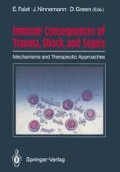Abstract
Microbicidal functions of the circulating neutrophil are well known to be temporally compromised following thermal or blunt traumatic injury. One function of the neutrophil grossly affected by injury is chemotaxis, or the ability to exit the vasculature and migrate directionally in response to one or more chemical signals generated at a site of inflammation. Defective patient neutrophil chemotactic function ex vivo has been reported by multiple laboratories using a variety of techniques [1–3] and has been reproduced in an animal model [4]. A decrease in the chemotactic response of neutrophils in vivo has also been documented for patients and animals with severe burns [5–7]. A defect in chemotactic function limits emigration of neutrophils from the circulation and likely contributes to the increased susceptibility to infection associated with thermal and traumatic injuries.
Supported in part by grants from the St. Paul-Ramsey Foundation, St. Paul-Ramsey Medical Center, St. Paul, Minnesota, by grant AI 22374 from the National Institutes of Health, DHHS, and by a grant from the International Fire Fighters Union.
Access this chapter
Tax calculation will be finalised at checkout
Purchases are for personal use only
Preview
Unable to display preview. Download preview PDF.
References
Warden GD, Mason AD Jr, Pruitt BA Jr (1974) Evaluation of leukocyte Chemotaxis in vitro in thermally injured patients. J Clin Invest 54: 1001–1004
Davis JM, Dineen P, Gallin JI (1980) Neutrophil degranulation and abnormal Chemotaxis after thermal injury. J Immunol 124: 1467–1471
Solomkin JS, Nelson RD, Chenoweth DE, Solem LD, Simmons RL (1984) Regulation of neutrophil migratory function in burn injury by complement activation products. Ann Surg 200: 742–746
Davis JM, Gallin JI (1988) Abnormal rabbit heterophil Chemotaxis following thermal injury. Arch Surg 123: 752–755
Yurt RW, Pruitt BA Jr (1985) Decreased wound neutrophils and indiscrete marginatum in the pathogenesis of wound infection. Surgery 98: 191–197
Balch HH (1963) Resistance to infection in burn patients. Ann Surg 157: 1–19
McCabe WP, Rebuck JW, Kelly AP, Ditmore DM (1973) Leukocyte response as a monitor of immunodepression in burn patients. Arch Surg 106: 155–159
Arturson G (1985) Neutrophil granulocyte functions in severely burned patients. Burns 11: 309–319
Nelson RD, Hasslen SR, Ahrenholz DH, Solem LD (1987) Mechanisms of loss of human neutrophil Chemotaxis following thermal injury. J Burn Care Rehabil 8: 496–502
Chenoweth DE, Hugli TE (1978) Demonstration of specific C5a receptor on intact human polymorphonuclear leukocytes. Proc Natl Acad Sci USA 75: 3943–3947
Fletcher MP, Gallin JI (1980) Degranulating stimuli increase the availability of receptors on human neutrophils for the chemoattractant f-Met-Leu-Phe. J Immunol 124: 1585–1588
Yuli I, Tomonaga A, Snyderman R (1982) Chemoattractant receptor functions in human polymorphonuclear leukocytes are divergently altered by membrane fluidizers. Proc Natl Acad Sci USA 79: 5906–5910
Goldman DW, Goetzl EJ (1984) Heterogeneity of human polymorphonuclear leukocyte receptors for leukotriene B4. J Exp Med 159: 1027–1041
Bender JG, Van Epps DE, Chenoweth DE (1987) Independent regulation of human neutrophil chemotactic receptors after activation. J Immunol 139: 3028–3033
Huey J, Hugli TE (1985) Characterization of a C5a receptor on human polymorphonuclear leukocytes. J Immunol 135: 2063–2068
Bokisch VA, Muller-Eberhard HJ (1970) Anaphylatoxin inactivator of human plasma: its isolation and characterization as a carboxypeptidase. J Clin Invest 49: 2427–2436
Perez HD, Goldstein IM, Webster RO, Henson PM (1981) Enhancement of the chemotactic activity of human C5adesArg by an anionic polypeptide (“cochemotaxin”) in normal serum and plasma. J Immunol 126: 800–804
Chenoweth DE, Cooper SW, Hugli TE, Stewart RW, Blackstone EH, Kirklin JW (1981) Complement activation during cardiopulmonary bypass. Evidence for generation of C3a and C5a anaphylotoxins. N Engl J Med 304: 497–503
Fast DJ, Schlievert PM, Nelson RD (1988) Non-purulent response to toxic shock syndrome toxin-1 producing Staphylococcus aureus: relationship to toxin-stimulated production of tumor necrosis factor. J Immunol 140: 949–953
Nelson RD, McCormack RT, Fiegel VD, Herron MJ, Simmons RL, Quie PG (1979) Chemotactic deactivation of human neutrophils: possible relationship to stimulation of oxidative metabolism. Infect Immun 23: 282–286
Nelson RD, Fiegel VD, Herron MJ, Gracyk JM, Bauman MP, McCormack RT, Simmons RL (1980) Chemotactic deactivation of human neutrophils: role of stimulation of hexose monophosphate shunt activity in nonspecific deactivation. Acta Physiol Scand [Suppl] 492: 31–41
Gallin JI, Wright DC, Schiffmann E (1979) Role of secretory events in modulating humane neutrophil chemotaxis. J Clin Invest 62: 1364–1374
Hinshaw DB, Sklar LA, Bohl B, Schraufstatter IU, Hyslop PA, Rossi MW, Spragg RG, Cochrane CG (1986) Cytoskeletal and morphologic impact of cellular oxidant injury. Am J Pathol 123: 454–464
Wulf E, Deboren A, Bantz FA, Faulstich H, Wieland T (1979) Fluorescent phallotoxin, a tool for the visualization of cellular actin. Proc Natl Acad Sci USA 76: 4498–4502
Editor information
Editors and Affiliations
Rights and permissions
Copyright information
© 1989 Springer-Verlag, Berlin Heidelberg
About this paper
Cite this paper
Nelson, R.D., Hasslen, S.R., Ahrenholz, D.H., Solem, L.D. (1989). Polymorphonuclear Leukocyte Function Following Burn and Mechanical Injury: Regulation and Kinetics. In: Faist, E., Ninnemann, J.L., Green, D.R. (eds) Immune Consequences of Trauma, Shock, and Sepsis. Springer, Berlin, Heidelberg. https://doi.org/10.1007/978-3-642-73468-7_25
Download citation
DOI: https://doi.org/10.1007/978-3-642-73468-7_25
Publisher Name: Springer, Berlin, Heidelberg
Print ISBN: 978-3-642-73470-0
Online ISBN: 978-3-642-73468-7
eBook Packages: Springer Book Archive

